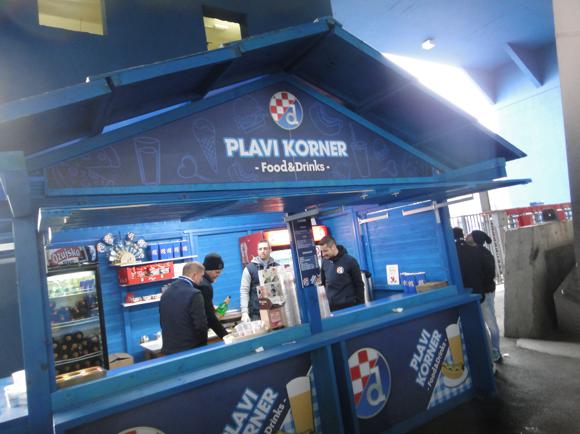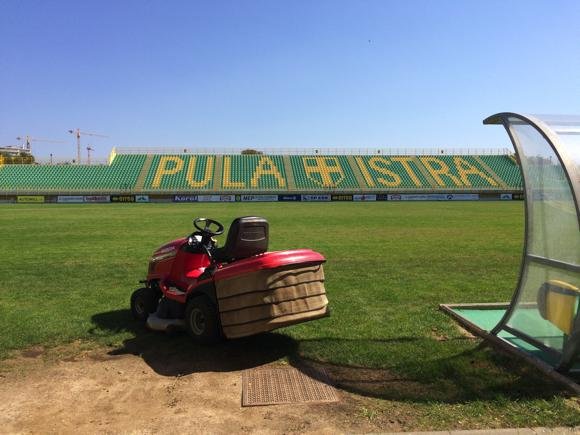The field of dreams – and the story behind it
Opposite the historic park of the same name, established by the eponymous local bishop who had this area of greenery landscaped and opened to the public in the late 1700s, the Maksimir has hosted soccer for over 110 years.
Organised football was first played here in 1912, the year the Croatian FA was formed. Of the city’s top three clubs of the pre-war era, Građanski, Concordia and HAŠK, it was the latter who considered the Maksimir their home ground.
As for the nascent Yugoslav national side, then representing the country known as the Kingdom of the Serbs, Croats and Slovenes, when in Zagreb they mainly used the Stadion Kranjčevićeva, former home of NK Zagreb.

But when Dinamo were formed from the disbandment of the city’s big three in June 1945, the Maksimir became their home and the main focus for football in Zagreb.
It was here that Dinamo staged three successful Yugoslav League campaigns (the 1948 side still played at Građanski’s Koturaska), and here that ‘Plavi’ overcame Leeds in the first leg of the successful Fairs’ Cup win of 1967.
And it was here, one sunny May afternoon in 1990, that Dinamo’s notorious Bad Blue Boys took on their equally notorious counterparts from Red Star Belgrade, the Delije, fans fighting on the pitch at a Yugoslav league game between the two.
The riot is seen as a symbolic prelude to the full-scale war that would break out between Serbs and Croats a year or so later. It is also known for the kick that Dinamo hero Zvonimir Boban aimed at a policeman (who turned out to be a Bosnian Muslim), springing to the defence of a Dinamo fan.

Since the break-up of Yugoslavia, despite a number of name changes, Dinamo have dominated the independent Croatian league. Only big international matches, derby games with Hajduk Split and occasional European games, see the Maksimir in its pomp. Everything else is routine and, with the BBB displeased with the Dinamo management, routine played out before low crowds.
For the Croatian national side, games with Serbia (October 1999, a 2-2 draw that sent the visitors to Euro 2000) and England (October 2006, a hilarious gaffe by goalkeeper Paul Robinson) have proved the most memorable. The Maksimir is the de facto national stadium, stage for the Vatreni who reached a World Cup semi in 1998 despite the significant limitations of the domestic league.
Renovations went on for over a decade. In the wake of Croatia’s success in France, an ambitious plan for a complete overhaul only got as far as the rebuilding of a new North Stand. Ten years later, another, cheaper, blueprint was reviewed. The 2011 installation of a new turf and seats was the first step in a gradual, more modest programme of redevelopment.

But with Croatian league attendances below an overall average of 2,000, travelling support for domestic fixtures is modest at best. Sadly, the Maksimir hardly fills for Croatia internationals, either – and rental for regular hosts Dinamo is steep.
In 2014, the club announced plans to move out and build a new stadium at Kajzerica in Novi Zagreb, the proposal gaining traction in the wave of enthusiasm after the 2018 World Cup. Since then, costs, logistics and the earthquake of 2020 have discounted this option, the thinking being that the Maksimir should be rebuilt.
In December 2023, agreement was reached between the City of Zagreb, the Croatian government and the Church – which has a claim to some of the land that will be needed for any new arena here – for the demolition of the existing Maksimir and the construction of a new stadium. A few months earlier, it had been announced that the Kranjčevićeva, where Dinamo would have to move during the rebuild, would also be reconfigured.

Dinamo announced the happy news in February 2024, after which followed months of stasis as an official complaint was made against the winning tender to rebuild the Kranjčevićeva.
In October 2024, with the Maksimir hosting Croatia’s Nations League game with Scotland, the Croatian public was still none the wiser as to any specific plan for a new Maksimir. There were even rumours that the site would be elsewhere, thus removing any thorny dispute with the Church. See Mystery surrounds the Maksimir.
The stadium currently comprises three stands: the main West (Tribina Zapad), the home North end and the South one opposite, where the handful of visiting fans are generally gathered. The East Stand, the Tribina Istok, remains closed off until safety inspectors sign it off as being secure enough to accommodate spectators, this side of the stadium having suffered most from the 2020 earthquake.






getting here
Going to the stadium – tips and timings


Take trams 4, 5, 7, 11 or 12 to the stop right by the stadium, Park Maksimir. The 11 and 12 run from the main square, Trg bana Josipa Jelačića. The 4 runs from the train station, Glavni kolodvor, the 5 and 7 from the bus station.
Some regional trains stop at Maksimir, the small station behind the stadium a ten-minute walk to the ground through a tangle of residential streets.
getting in
Buying tickets – when, where, how and how much



There’s a Ticket Point (Mon-Fri 9am-5pm) in the stadium’s main forecourt, through the car park. For details of admission for domestic fixtures, see Dinamo Zagreb.
For national games, visiting fans should source tickets through their individual associations. Neutral fans looking to see a Croatia game can find information on the FA website.
Where to Drink
Pre-match beers for fans and casual visitors








As you approach the stadium from town, sundry bars line Maksimirska cesta. Kocka (No.104), Boro’s (No.119) and Storm (No.123) are closest to the stadium..
Also on this side of the road, just inside the park gates, the Restoran Maksimir is a lovely restaurant and terrace bar, tables spread out on a wide, gravel space backdropped by trees. There’s a full Croatian menu too, including the Zagreb specialities of štrukli pastry, breaded meat, plus a hulking great house platter for two hungry carnivores.
Further into the park, overlooking the first lake you come to, Mirna Koliba was a bit hit when it opened in 2024, just a few chairs and tables at the water’s edge, and a kiosk dispensing Heineken and Karlovačko. Rowboats bob to one side, the Maksimir floodlights beckon from across the water. Winter opening is promised.












Across the road, at the junction of Maksimirska cesta and Donje Svetice by the stadium car park, Caffè Royal and Maksimilijan are standard Croatian café-bars. The latter has a TV and slightly more atmosphere. Further down, Daba is more comfortable, with a terrace in summer and archive images of Zagreb in the little interior. Note also the huge BBB mural outside.
On this side of the stadium, turning left at the Svetice transport stop, the Ožujsko Pub Maksi on Budaka Divka is a league above, a large, modern sports bar/restaurant with beer brewed on-site. There should be no doubt as to the main sponsor here, underlined by the beer-barrel lampshades and vintage Ožujsko ads. Regulars tuck into towering burgers amid the plentiful TV screens tuned to football.
Within the ground, Plavi Korner kiosks serve snacks and, depending on the fixture, Ožujsko beer.








